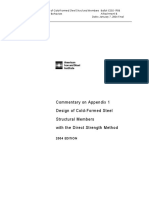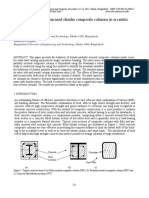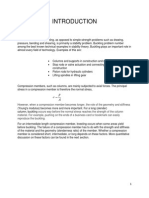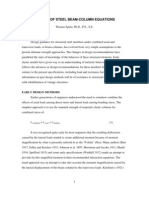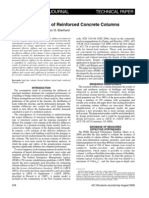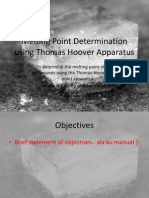Rack January 2001 Opus2
Rack January 2001 Opus2
Uploaded by
فتوح عبد العال خميسCopyright:
Available Formats
Rack January 2001 Opus2
Rack January 2001 Opus2
Uploaded by
فتوح عبد العال خميسCopyright
Available Formats
Share this document
Did you find this document useful?
Is this content inappropriate?
Copyright:
Available Formats
Rack January 2001 Opus2
Rack January 2001 Opus2
Uploaded by
فتوح عبد العال خميسCopyright:
Available Formats
DESIGN OF INDUSTRIAL STORAGE RACKS
by
Teoman Pekz and Kotha Rao
Cornell University, Ithaca, New York, USA
SUMMARY
The current Design Provisions for Steel Industrial Storage
Racks are summarized and a progress report on a current
Cornell University Research project is given.
The design of industrial steel storage racks presents several challenges to the structural
engineer. Presently the design in the United States is carried out according to the 1997
edition of the Specification (1) published by the Rack Manufacturers Institute (RMI).
The RMI first published its first Minimum Engineering Standards for Industrial Storage
Racks in 1964.
The work that resulted in the first edition of the Specification was initiated by the RMI in
1972 at Cornell University. Several editions of the Specification have been prepared
based on the work by the RMI Specification Advisory Committee and the researchers at
Cornell under the supervision of Professors George Winter and Teoman Pekz until
1979 and under the supervision of senior author since 1979. The RMI Specification is
tied closely to the AISI Specification [2] for the provisions on Cold-Formed Steel Design.
The Australian Specification for racks is based primarily on the RMI Specification with
some regional enhancements. The applicable standard in Europe [3] is described in
some detail in Reference [4].
The discussion in this article will be on the RMI Specification and the current research at
Cornell on evolving and improving the RMI Specification. The discussion on the loads
specified in the RMI Specification will be limited to Load and Resistance Factor Design.
The extensive earthquake provisions of the RMI Specification will not be discussed in
this article.
Most of the current research on racks in the United States is being conducted at Cornell
University with the senior author as the principal Investigator for the project. The focus
of the discussion in this paper is on the progress to date at Cornell University, and the
conclusions may change based upon future research.
The research uses finite element solutions verified by tests on both the component and
the global scale. On the component level, the topics focused upon are the behavior of
joints, and the interaction of the frames with their column bases.
1
1. SOME FEATURES OF THE 1997 RMI SPECIFICATION (1)
1.1 Loads
Dead and live loads on racks are only a small portion of the total load on racks. Product
load is a major portion of the loads applied on a rack structure. The Specification
defines the product load as the products or pallet loads stored on a rack. Since the
product load is usually well defined and listed on the plaques placed on the racks, lower
load factors are specified for the Load and Resistance Factor Design of racks that for
live loads. Below are two examples of load factors and load combinations out of eight
given in the Specification:
1.4DL + LL + 1.2PL
1.2DL + 1.6LL + 0.5(SL or RL) + 1.4PL
DL and LL are dead and live loads, respectively. SL and RL snow and rain loads,
respectively. PL is the product load.
Beam support connections, frame bracing, and frame bracing to column connections of
racks are to be designed for horizontal loads equal to 1.5% of the factored dead load
and factored product load. The horizontal forces include the effect of out-of-plumbness.
The tolerance for out-of plumbness is given as 0.5 inches in 10 feet of height. The
horizontal forces are to be applied separately, not simultaneously, in each of the two
principal directions of the rack. The beam support connection moments are to be
checked against the permissible moments (both positive and negative) determined from
Cantilever Tests and/or Portal Tests (Fig. 1 and 2).
1.2 Design of Steel Elements and Members
The design of steel elements and members are carried out according to the AISI
Specification [2] for cold-formed members and AISC Specification [5] for hot-rolled
members. Some exceptions and modifications to these Specifications are noted in the
Specification. Some of these exceptions and modifications will be discussed briefly.
The load carrying capacity beyond local buckling (post-buckling strength) is quite
significant for cold-formed steel racks. For this reason some extensions to the AISI
Specification had to be made.
Nominal bending moment capacity
n
M is obtained by multiplying the effective section
modulus
e
S
by the yield stress
y
F
. The effective section modulus
e
S
for perforated
members is to be determined by multiplying the elastic section modulus of the net
section by
2
0.5
2
Q _
+
,
.
This expression was obtained through reasoning that the effect local buckling would be
less significant for flexural members than that for axially loaded members. The factor Q
is determined by tests on axially loaded stub columns. Using this value of Q for flexure
would be too conservative. The above modification factor accepts one half of Q for the
compression part of the section but takes the full section for the tension part.
The interaction of lateral buckling with local buckling needs to be accounted for; thus,
the expression for calculating member strength as for lateral buckling involves the
effective section modulus at lateral buckling stress
c
S
. Modulus
c
S
is calculated by
multiplying the net section modulus by the factor
/ 1
1
2
c f
y
M S Q
F
_
,
.
In this expression
c
M
is the lateral buckling moment,
f
S is the section modulus for the
full section and Q is determined by stub column test. Though the specification does not
point it out, Q could be determined by the expression
0.5
2
stubcolumntest
Q
Q
_
+
,
as reasoned out above. The above factor is derived in accordance with the approach
described in Reference [6].
As required by the AISI Specification, nominal strength of a column is determined by
multiplying the column limit-state stress
n
F by the effective area
e
A
at stress
n
F . This
accounts for the interaction of local and overall column buckling. Studies on the
interaction of the distortional buckling and overall buckling require special consideration.
A research project on this subject has just been completed. The results have not yet
been published. However, it is expected that the future editions of the RMI Specification
will have provisions on theis subject. The effective area is determined by the expression
( )
min
1 1
Q
n
e net
y
F
A Q A
F
1
_
1
1
,
]
where
min net
A
is the minimum cross-sectional area obtained by passing a plane through
the column normal to the axis of the column. This expression is derived in Reference
[6].
1.3 Frame Design
Frame design involves the use of effective length factors which are specified for various
situations and the interaction equations given in the AISI Specification.
3
Racks in general consist of upright frames and beams connecting the upright frames.
Upright frames consist of two columns braced together. There may or may not be
bracing in the down-aisle direction, namely in the direction perpendicular to the upright
frames.
The current practice is to do a linear analysis and account for the second order effects
by a magnification factor
. For cold-formed steel racks, an interaction equation is used
in the AISI Specification. The following is a simplified explanation of the AISI interaction
equation. This interaction equation can be expressed as follows:
n n
P M
P M
+ 1
where P is the axial load in the column being checked determined by linear analysis.
The moment determined by linear analysis
lin
M is multiplied by the magnification factor
to obtain the second order moment M to be used in the interaction equation.
lin
M M
The moment Mmay further be modified to account for moment gradients. The
magnification factor
is defined as
e
P
P
1
where
e
P
is the elastic buckling load of the column about the bending axis. Thus the
effective length is determined for buckling about the bending axis.
The terms
n
P and
n
M are the limit-state axial load and bending moment, respectively,
when each acts separately. For bending about the symmetry axis, as is the case for
buckling in the down aisle direction, the terms
n
P and
n
M are determined using effective
length factors
K
and
x
K with the nominal strength equations given in the AISI
Specification.
Effective length factor for torsional buckling
K
is to be taken as 0.8. The Specification
gives some conditions for exceptions to this value. The effective length factor for
buckling about the centroidal axis of the column section perpendicular to the aisle
x
K (in
general this is the axis of symmetry) can be determined either by rational analysis or
taken as 1.7. The Specification gives some guidelines for determining
x
K by rational
analysis that it should account for the member stiffnesses, the semi-rigid nature of the
beam to column connections and the partial fixity of the base, allowing for average load
reduction, as applicable. It is noted that if
x
K of 1.7 is used without analysis, then no
reduction of this value shall be made
A common approach for determining effective length factors is the use of alignment
charts. Some guidance for the use of the alignment charts is given in the Commentary
4
to the Specification [5]. For racks not braced against side sway in the application of
alignment charts, the beam slenderness
/
b b
I L
is to be replaced by ( ) /
b b
red
I L
1 6
b b b
b b red
b
I I L
L EI
L F
_
1
,
+
1
]
where
b
I
= the actual moment of inertia of the pallet beam
b
L
= the span of the pallet beam measured between the centroids of the columns
supporting the beam
F
= the joint rigidity determined by the Portal Test
E = modulus of elasticity
The analysis for the effective length factor for the portion of the column from the floor to
the first beam level would involve the following G values as defined in the commentary
of Ref. [5].
1 2 1
1 1
2
c
e
c c c
a b
f
b
f
b
red
I
I
L L L
G andG
I
I
L
L
_
+
,
_
,
where
c
I
= the column moment of inertia
1 c
L
= the distance from the floor to the first beam level
2 c
L
= the distance from the first beam level to the second beam level
The fixity implied at the column base by the equation above can be calculated as
2
1440
f
f
I bd
L
(all dimensions in inches)
2
3
1440(25.4)
f
f
I bd
L
(all dimensions in mm)
where
b = the width of the column (parallel to the flexure axis)
d = the depth of the column (perpendicular to the flexure axis)
For the above equation, the floor is assumed to be concrete, and the column connection
to the floor must be adequate to develop base moments consistent with this stiffness.
For other floor material the equation should be modified.
5
Similar rules are given for design of frames perpendicular to the aisle and for braced
frames.
1.4 Tests
Several tests are prescribed in the RMI Specification for the determination of
parameters that are difficult to determine computationally. Here a few of these tests will
be mentioned briefly.
1.4.1 Stub Column Tests
Because of the interaction of local buckling, perforations and cold-forming effects it is
necessary to carry out stub column tests on a short segment of a column to determine
the behavior. These tests are carried out in accordance with the rules given in the AISI
Specification. The rules are modified as applicable to the rack columns. The RMI
Specification also gives rules for evaluating the test results.
1.4.2 Cantilever Tests
The test setup shown in Fig. 1 is used to determine the moment-rotation behavior of the
mechanical joints of racks.
1.4.3 Portal Tests
The test setup shown in Fig. 2 is used to determine the moment rotation behavior of
mechanical rack joints as well. The portal test reflects the effect of the vertical forces on
the connection more accurately. However, this test is more difficult to conduct. The
hinges at the column bases are prevented from moving in the plane of loading.
2. CURRENT CORNELL UNIVERSITY RESEARCH ON COLD-FORMED STEEL
FRAMES
As seen in the discussion of the current RMI Specification above, the behavior and
ultimate strength of a typical rack frame is characterized by many parameters. These
parameters include: flexibility of beam-to-column joints, column base fixity, perforations
in the columns, local buckling of member components, geometric and material
imperfections and complex bucking behavior of column members. Important features
and the tentative results of ongoing research are discussed below. The discussion
below is a progress report on the findings and may change on the basis of the findings
during the rest of the project.
The studies make extensive use of ABAQUS a commercial finite element method
(FEM) software to validate design approaches. Whenever possible the FEM solutions
are compared with physical test results to gain confidence in the modeling technique.
6
Various types of shell elements and beam elements are used. The shell-contact
element model and beam-spring element model are used to model the various features
of the components and entire frame behavior.
While the shell and contact element model is accurate and reliable, it has been found
that modeling of full frames by shell elements is tedious, computationally expensive and
requires experienced analysts. This model best serves in validation studies (as an
alternative to experiments) to evaluate the performance of other simpler numerical and
analytical models.
2.1 ANALYSIS
2.1.1 Behavior of Frame Components
2.1.1.1 Beam-to-column joint flexibility:
The connection between the shelf beam and column members of pallet rack frames is
generally flexible and influences the frame behavior significantly.
The current RMI specification accounts for the effect of joint flexibility on column
strength by modifying the pallet beam stiffness and in turn modifying the column end
restraint offered by the beam member as discussed in Section 1.3 above.
The joint stiffness is to be determined experimentally by individual manufacturer using
the test setup that is mentioned in Sections 1.4 and 1.5. The specification suggests
using the secant stiffness corresponding to 0.85 times the ultimate moment capacity of
the joint as determined from physical tests. While the specification procedure is simple
to use, there may be cases where the above assumption/simplification does not hold
true. Hence, it is always rational and safe to use the correct joint stiffness value in the
frame analysis by adopting joint M relationship valid through the entire load history.
In the present study such expressions are developed by making use of the experimental
data available in the form of moment-rotation history of a variety of joints as provided by
different manufacturers. A total of 6 joint types typical to the ones used in the United
States are considered in the present study. The FEM idealization used and its accuracy
is illustrated in Fig. 3.
2.1.1.2 Column Base Fixity:
The column base stiffness of pallet rack frames is characterized by the base plate
dimensions, number, dimensions and layout of bolts, ratio of moment to axial load at the
column base and foundation characteristics. The degree to which each parameter
effects the base stiffness depends on the way the column is connected to the
foundation.
7
In the present study, the base stiffness characteristics due to bending of the base plate
are studied by means of Finite Element Method. FEM idealization of the column base is
illustrated in Fig. 4. Contact elements, shell elements and spring elements are used in
the finite element modeling of the problem. The following observations have been made
based on a large parametric study on an isolated lipped channel column member.
The moment-rotation relationship of a typical pallet rack frame base is generally
nonlinear
The higher the axial load on the column, the stiffer is the column base.
While the axial load increased the base stiffness by about 20% when the base plate
is thin (0.25``, 6.25 mm, thinnest of plates studied), its effect is found to be
insignificant in the case of thicker plates
When the axial load on the column is accompanied by only a small amount of lateral
load (1.6% of axial load), the column base stiffness is found to be very close to that
of RMI specification value
For lateral load to axial load ratios other than 0.016, the initial stiffness of column
base is found to vary from 0.3-0.7 times the RMI specification value, depending on
the base plate configuration and amount of axial load on the column.
The effects of base plate configuration (plan dimensions) and number of bolts on the
base stiffness are found to be negligible. However in the case of thinner plates,
smaller plate configurations seem to help slightly increase the base stiffness.
2.1.2 Frame Behavior:
First, a parametric study has been carried out on four types of commonly used pallet
rack frames tested at Cornell University in the 1970s. This was done to establish
guidelines to prepare FEM models to study the behavior accounting for the influence of
various parameters discussed above. A FEM idealization and a view of a physical test is
illustrated in Fig. 5.
First the effect of warping constraint at column bases was studied. It was found that the
influence of the warping constraint on the frame strength depends on the type of column
members. The difference between the strengths of warping free and warping fixed
cases may vary from 4% to 25%. A limited parametric study showed that the warping
fixed case simulates the actual condition better.
Frames were modeled using shell and beam elements. It was found that beam
elements with proper care are capable of estimating the frame strengths accurately
when compared to experimental and shell element based FEM results.
Based on physical test results and FEM studies it was found that the current RMI
Specification may under estimate the strengths of pallet rack frames up to about 50%.
This establishes the need to review and improve the current design procedure.
8
While the Specification procedure has been made conservative in the absence of
knowledge of the effect of various parameters on the system behavior, it is not known to
what magnitude each of these parameters affect the accuracy of the design procedure.
A large parametric study involving nonlinear finite element analysis of 5 types of pallet
rack frames has been carried out to quantify the conservatism of the current procedure.
The factors focused on are the use of approximate effective length factors, linear beam-
column interaction equation and linear amplification factor. When the column base
stiffness is taken as specified in the RMI as discussed in Section 1.3 above, it was
observed that:
The strength estimates by taking
0.8 K
and 1.7
x
K are satisfactory for the
gravity together with lateral load cases. The calculated capacities in these cases are
conservative by 10%-15%. However, for the Gravity load only case, the specification
is found to be conservative by as much as 40%.
The strength estimates by taking
0.8 K
and determining
x
K from alignment
charts are found to be 20-50% conservative when load on the frame is checked for
either gravity or gravity together with small lateral loads. The estimates become 15-
25% conservative for large lateral loads.
When the column base stiffness is taken as one half of what is specified in the RMI
Specification as discussed in Section 1.3 above, it was observed that:
Taking
0.8 K
and 1.7
x
K is conservative by 10-35%.
Taking
0.8 K
and determining
x
K from alignment charts P is conservative by 20-
40% when the load on the frame is either gravity or gravity together with small lateral
loads and about 15-25% for large lateral loads.
In order to improve the current design procedure, several design methods using the
present AISI and AISC procedures for frames and beam columns are being tried. It was
found that the frame design procedure given in the AISC-LRFD Specification [5] with
1.0 K
and 1.0
x
K in conjunction with either initial beam-to-column joint stiffness or
secant stiffness might predict the frame strengths with sufficient accuracy. The AISC-
LRFD equations can be summarized as follows:
1 0.2
2
n n n
P M P
for
P M P
+
8
1 0.2
9
n n n
P M P
for
P M P
+ >
1
1
lin
M M
P
H L
9
The terms used in these equations are the same as the ones defined in Section 1.3
above. Furthermore is the inter-story deflection for horizontal forces
determined by linear analysis,
H
is sum of all story horizontal forces
producing and L is the story height.
The above conclusions are based on two dimensional frame analyses. Three
dimensional frame analyses are being planned for the near future. The conclusions may
change on the basis of these planned studies.
2.2 Summary
The behavior of pallet rack frames with semi-rigid beam-column joints and flexible
column bases is studied by experimental and numerical (FEM) investigations. A general
M relationship was established to model the beam-to-column joint stiffness of
some pallet rack frames. The column base flexibility of rack frames caused by base
plate bending is studied in detail and quantified in terms of the current specification
value. Guidelines for carrying out nonlinear FEM analysis of rack frames accounting for
various influencing parameters are also being studied.
A critical review of the current RMI Specification [1] was carried out. The RMI
Specification was found to be conservative with regard to strength estimates. The
sources of conservatism in the specification were identified. Improvements to the RMI
Specification are being sought. The improvements are being sought in effective length
factors, beam-column interaction equations and moment amplification factors.
3. ACKNOWLEDGEMENTS
The Cornell University research project discussed in this article is co-sponsored by the
Rack Manufacturers Institute and the American Iron and Steel Institute. This four-year
project is in its third year. Dr. Kotha Rao worked on this project during the first two years
as a post-doctoral researcher. Presently, Andrew Sarawit, a graduate research
assistant is assigned to the project.
The support of the Rack Manufacturers Institute and its Specification Advisory
Committee chaired by Mr. Daniel Clapp, and the support of the American Iron and Steel
Institute and its Subcommittee on the research chaired by Mr. James Crews are
gratefully acknowledged.
The authors also wish to thank Mr. John Nofsinger of the RMI, Dr. Helen Chen of the
AISI, Prof. R. Zandonini and Ms. Nadia Baldassino for their help.
4. REFERENCES
[1] Rack Manufacturers Institute, Specification for the Design, Testing and
Utilization of Industrial Storage Racks, Charlotte, NC, USA, 1997
10
[2] American Iron and Steel Institute, Specification for the Design of Cold-Formed
Steel Structural Members, Washington, DC 1996
[3] Federation Europeanne de la Manutention (Section X) The Design of Steel
Static Pallet Racking, FEM Document 0.2.02, March 1998
[4] Davies, J. M., Light Gauge Steel Construction, Progress in Structural
Engineering, Vol. 2No. 1, January March 2000
[5] American Institute of Steel Construction, LRFD Manual of Steel Construction
second edition, Chicago, IL, 1998
[6] Pekz, Teoman, Development of a Unified Approach to Design of Cold-
Formed Steel Members, AISI Report S. G.- 86-4, 1986
5. GENERAL REFERENCES
The references in this section are relevant to the subject of the paper. The references
that are Cornell University Reports published prior to 1982 may not be available.
Godley, M. H. R., Beale, R. G., and Feng, X. (2000) Analysis and design of
down-aisle pallet rack structures. Comp. Struct., 77, 391-401.
Baldassino, N. Bernuzzi, C., Zandonini, R:, Experimental analysis on key
components of steel storage pallet racking systems, Proceedings of the 7th
International Symposium on Structural Failure and Plasticity (IMPLAST 2000),
Melbourne, 4-6 ottobre 2000, (accettato per la pubblicazione negli atti del
convegno).
Baldassino, N. Bernuzzi, C., Analysis and Behaviour of Steel Storage Pallet
Racks, Thin-Walled Structures, Vol. 37, n 4, pp. 277-304, 2000
Baldassino, N., and Hancock, G. J. (1999) Distortional buckling of cold-formed
steel storage rack sections including perforations. Proc., Light-Weight Steel and
Aluminium Structures, Helsinki, 21-23 June 1999, P. Makelainen and R
Hassinen, eds., Elsevier Science, 131-138.
Olsson, A. M. J., Sandberg, G. E., and Austrell, P. E. (1999) Load-carrying
capacity of damaged steel columns with channel sections. J. Struct. Eng., 125,
338-343.
Baldassino, N. Bernuzzi, C., Zandonini, R:, Influence of Beam-to-Column Joint
Modelling, Festschrift Prof. Ferninand Tschemmernegg. G. Huber and T. Michl
ed. Institute of Steel and Timber Construction, University of Innsbruck, A, 1999,
349-363.
11
Baldassino, N. Bernuzzi, C., Zandonini, R:, Structural Analysis of Steel Storage
Pallet Racks, Proceedings of the 6th International Colloquium on Stability
Ductility of Steel Structures (SDSS 99), Timisoara, Romania, 9-11 settembre
1999, 465-475.
Baldassino, N., Hancock, G. Distortional Buckling of Cold-Formed Steel Storage
Rack Sections including Perforations, Proceedings of the Fourth International
Conference on Steel and Aluminium Structures (ICSAS 99), Elsevier , Espoo,
Finland, 20-23 giugno 1999, 131-138.
Baldassino, N. Bernuzzi, C., Zandonini, R:, Design Analysis of Steel Storage
Pallet Racking Systems, Atti del XVII Convegno C.T.A. - volume 2, Napoli, 3-7
ottobre 1999, 75-85.
Davies, J. M., and Godley, M. H. R. (1998) A European design code for pallet
racking. Proc., 14h Int. Specialty Conf. Cold-Fonned Steel Structures, St.
Louis, Missouri, 15-16 October, 289-3 10.
FEM (1998). Recommendations for the Design of Static Steel Pallet Racking
and Shelving, FEM 10.2.02, Federation Europeene de La Manutention.
Tide, R. H. R., and Calabrese, F. A. (1998) Investigation of collapsed rack
storage systems. Thin-walled Structures, N. E. Shanmugam et al., eds.,
Elsevier, Oxford, 493-500.
Baldassino, N. Bernuzzi, C., Zandonini, R:,Experimental and Numerical Studies
on Pallet Racks, Proceeding of the Conference Professor Otto Halase-
Memorial Session, Tecnical University of Budapest, TU Budapest publ., 1998 (in
print).
Baldassino, N. Bernuzzi, C., Zandonini, R:, Hancock, G. Overall, local and
distortional buckling in pallet racks, Proceedings of the 1998 Workshop Frames
with Partially Restrained Connections organised by Structural Stability Research
Council (S.S.R.C.), Atlanta (GA-U.S.A.), settembre 1998 (in print).
ASCE (1997). Effective Length and Notional Load Approaches for Assessing
Frame Stability: Implications for American Steel Design, American Society of
Civil Engineers, New York.
Dunai, L., Hegedus, T., Kaltenbach, L., and Adany, S. (1997) Experimental and
numerical studies on the stability of racking frames. Stability and Ductility of
Steel Structures, T. Usami, ed., Japanese Society of Steel Construction, 647-
652.
12
Markazi F.D., Beale R.G., Godley M.H.R., 1997, Experimental Analysis of Semi-
Rigid Boltless Connectors, Thin-Walled Structures, Vol.28, n1, pp.57-87.
Li, T. Q., Choo, B. S., and Nethercot, D. A. (1995) Connection element method
for the analysis of semi-rigid frames. J. Construct. Steel Res., 32, 143-17 1.
SA (1993a). Steel Storage Racking, AS 4084-1993, Standards Australia,
Homebush, New South Wales.
SA (1993b). Steel Storage Racking- Commentary, Supplement to AS 4084-
1993, Standards, Australia, Homebush, New South Wales.
Davies, J. M., "Down-Aisle Stability of Rack Structures," Proceedings of the
Eleventh Specialty Conference on Cold-Formed Steel Structures, St. Louis,
Missouri, October 20-21, 1992.
Lewis, G. M. (1991) Stability of rack structures. Thin-Walled Struc., 12, 163-
174.
Pekoz, Teoman, Design of Perforated Cold-Formed Steel Columns Proceeding
of 9th International Specialty Conference, Cold-Formed Steel Structures, St.
Louis, MO, November 1988.
Bridge, R. Q., and Fraser, D. J. (1987) Improved G-factor method for evaluating
effective lengths of columns. J. Struct. Engrg., 113, 1341-1356.
Pekoz, Teoman, Design of Perforated Cold-Formed Steel Columns, Report
October 11, 1987.
Roos, O., and Hancock, G. J. (1986) Flexural-torsional buckling of storage rack
columns. Proc., 8th Int. Specialty Conf. Cold-Formed Steel Structures, 11-12
Nov 1986, St. Louis, Missouri.
Hancock, G. J. (1985) Distortional buckling of steel storage rack columns. J.
Struct. Eng.,
Pekoz, Teoman, Effective Length Study, Report January 1, 1982.
Pekoz, Teoman, Effective Length Study, Report January 22, 1982.
Pekoz, Teoman, Base Fixity Study, Report January 1981.
Pekoz, Teoman Design of Cold-Formed Steel Storage Racks Proceedings,
International Conference on Thin-Walled Structures, University of Strathclyde,
U.K. April 1979.
13
Pekoz, Teoman, and Winter, George Column Tests on Cold-Formed Steel Rack
Posts, Department of Structural Engineering Report, Cornell University, Ithaca,
New York, 1974.
Pekoz, Teoman, and Winter, George Interpretation of Column Tests on Cold-
Formed Steel Rack Posts and a Possible Design Approach, Report, September
1974.
Pekoz, Teoman, and Winter, George Cold-Framed Steel Rack Structures,
Proceedings, Second Specialty Conference on Cold-Formed Steel Structures,
University of Missouri-Rolla, October 1973.
Pekoz, T. and Winter, G. Torsional-Flexural Buckling of Thin-Walled Sections
under Eccentric Loading, J. of the Structural Division, ASCE, May 1969
Chajes, A., and Winter, G. (1965) Torsional-flexural buckling of thin-walled
members. J Struct. Div., ASCE, 91 (4),103-124.
Timoshenko, S. P., and Gere, J. M. (1961). Theory of Elastic Stability, 2 d ed.,
McGraw-Hill, New York.
14
Fig. 1 Cantilever Test Setup
Fig. 2 Portal Test Setup
15
Fig. 3 Simulation of Cantilever tests to get Moment-Rotation Curves. Dashed lines
are for two different ways of simulating the joints. One simulation assumes
full continuity whereas the other uses contact elements to model the joint
more realistically. Solid lines are for physical test results
Fig. 4 FEM Simulation of Column Base
16
Fig. 4 Finite element simulation of a physical test on system level using shell
elements
17
You might also like
- Design of Cold-Formed Steel by Direct MethodDocument24 pagesDesign of Cold-Formed Steel by Direct MethodLaura ManolacheNo ratings yet
- ESSENTIAL OIL Steam Distillation Steam DistillerDocument8 pagesESSENTIAL OIL Steam Distillation Steam DistillerSerene InNo ratings yet
- Design - Lateral Load Resisting Frames SJs JGsDocument16 pagesDesign - Lateral Load Resisting Frames SJs JGsclam2014No ratings yet
- Analysis and Design of Framed Columns Under Minor Axis BendingDocument50 pagesAnalysis and Design of Framed Columns Under Minor Axis BendinglasithajayasekaraNo ratings yet
- Practical Compactness and Bracing Provisions For The Design of Single Angle BeamsDocument7 pagesPractical Compactness and Bracing Provisions For The Design of Single Angle Beamsbruno_alqNo ratings yet
- ACKROYD - Simplified Frame Design of Type PR ConstructionDocument6 pagesACKROYD - Simplified Frame Design of Type PR ConstructionValentin Vergara GonsagaNo ratings yet
- Ch11 Stability of Angle MembersDocument38 pagesCh11 Stability of Angle MembersErnie ErnieNo ratings yet
- Cold-Formed Steel Frame and Beam-Column Design PDFDocument62 pagesCold-Formed Steel Frame and Beam-Column Design PDFEduardo InfanteNo ratings yet
- Discussion - Buckling of One-Story FramesDocument7 pagesDiscussion - Buckling of One-Story FramesAntoine Lance0% (1)
- A New Approach For Design of Steel Beam-Columns Our A.Document32 pagesA New Approach For Design of Steel Beam-Columns Our A.mbrown4382No ratings yet
- Sample Seismic Analysis ReportDocument14 pagesSample Seismic Analysis ReportricardobonillaNo ratings yet
- Rationale For The ACI 440.1R-06 Indirect Deflection Control Design ProvisionsDocument20 pagesRationale For The ACI 440.1R-06 Indirect Deflection Control Design ProvisionsmirzaNo ratings yet
- Surovek Et Al. - Guidelines For The Use of Direct Second-Order Inelastic Analysis - 2007Document26 pagesSurovek Et Al. - Guidelines For The Use of Direct Second-Order Inelastic Analysis - 2007Jorge ChoqueNo ratings yet
- Models - Sme.truss Tower BucklingDocument22 pagesModels - Sme.truss Tower Bucklingjas fasolaNo ratings yet
- Unified - Flexural - Resistance - Equations - For - Stability Design of Steel I-Section Members OverviewDocument21 pagesUnified - Flexural - Resistance - Equations - For - Stability Design of Steel I-Section Members OverviewKelvin LuoNo ratings yet
- Behavior of Partially Encased Slender Composite Columns in Eccentric Loading by Saima Ali, Mahbuba Begum PDFDocument10 pagesBehavior of Partially Encased Slender Composite Columns in Eccentric Loading by Saima Ali, Mahbuba Begum PDFgulilero_yoNo ratings yet
- Input Parameters For Inelastic Seismic Analysis of R/C Frame StructuresDocument8 pagesInput Parameters For Inelastic Seismic Analysis of R/C Frame StructuresAris CapNo ratings yet
- 1997 Dámbrisi and FilippouDocument20 pages1997 Dámbrisi and FilippoufsimaNo ratings yet
- Critical Lateral-Torsional Buckling Moments of Steel Web-Tapered I-BeamsDocument8 pagesCritical Lateral-Torsional Buckling Moments of Steel Web-Tapered I-BeamsCarloDoimoNo ratings yet
- 1959 Galambos & Ketter - Columns Under Combined Bending and ThrustDocument49 pages1959 Galambos & Ketter - Columns Under Combined Bending and ThrustAKNo ratings yet
- UB As ColumnsDocument16 pagesUB As ColumnssuvraNo ratings yet
- Comparison of a steel column design buckling resistance between the South African/Canadian (SANS 10162-1:2005/CAN/CSA-S16- 01:2005), Eurocode 3 (EN 1993-1-1:2005) and Australian /New Zealand (AS4100:1998/NZS3404:1997) standards- Part II: South African Hot-Rolled I- SectionDocument8 pagesComparison of a steel column design buckling resistance between the South African/Canadian (SANS 10162-1:2005/CAN/CSA-S16- 01:2005), Eurocode 3 (EN 1993-1-1:2005) and Australian /New Zealand (AS4100:1998/NZS3404:1997) standards- Part II: South African Hot-Rolled I- SectionIOSRjournalNo ratings yet
- Parametric Study of Cold Formed Steel Zee Sections For Optimum Design StrengthDocument8 pagesParametric Study of Cold Formed Steel Zee Sections For Optimum Design StrengthKAVITHA GARIDINo ratings yet
- Columns 6Document113 pagesColumns 6d584cnNo ratings yet
- Panel ZonesDocument10 pagesPanel ZonesGabriel PatileaNo ratings yet
- 2006-Ultimateflexural Strength Hollow SectionsDocument7 pages2006-Ultimateflexural Strength Hollow Sectionsvijay2192No ratings yet
- Chrome-Extension Mhjfbmdgcfjbbpaeojofohoefgiehjai IndexDocument9 pagesChrome-Extension Mhjfbmdgcfjbbpaeojofohoefgiehjai IndexfdafaNo ratings yet
- ACI ITG/T1.1R-99: Reported by ACI Innovation Task Group 1 and CollaboratorsDocument7 pagesACI ITG/T1.1R-99: Reported by ACI Innovation Task Group 1 and CollaboratorsCorui Mihai ValerNo ratings yet
- Flange Bracing Requirements For Stability of Metal Building SystemsDocument12 pagesFlange Bracing Requirements For Stability of Metal Building SystemsTim PopikNo ratings yet
- CH4 Compression MembersDocument78 pagesCH4 Compression Membersrawan alguniematNo ratings yet
- Design Criteria For Steel Transmission PolesDocument25 pagesDesign Criteria For Steel Transmission PoleskunhalparikhNo ratings yet
- Design Analysis of Light StructuresDocument17 pagesDesign Analysis of Light StructuresgligamsnNo ratings yet
- Inelastic Strength of Laterally Unsupported Top-Loaded Built-Up Slender Beams - WASET - Barcelona 2013Document9 pagesInelastic Strength of Laterally Unsupported Top-Loaded Built-Up Slender Beams - WASET - Barcelona 2013steelfaceNo ratings yet
- 273 10Document52 pages273 10Dr Axel ChangNo ratings yet
- Steel Beam Column With Braced FrameDocument21 pagesSteel Beam Column With Braced Framearno assassinNo ratings yet
- The 1996 AISI SpecificationDocument14 pagesThe 1996 AISI SpecificationRonnie1478No ratings yet
- Connections in Precast Concrete Structures-Strength of CorbelsDocument46 pagesConnections in Precast Concrete Structures-Strength of CorbelsAnandhiNo ratings yet
- Https WWW - Sefindia.org Q System Files Confinement+Reinforcement+for+Columns-ICJ Aug+11Document9 pagesHttps WWW - Sefindia.org Q System Files Confinement+Reinforcement+for+Columns-ICJ Aug+11Igor GjorgjievNo ratings yet
- Performance of Base-Plate Connections of Steel Storage Pallet RacksDocument10 pagesPerformance of Base-Plate Connections of Steel Storage Pallet RacksAlan GironNo ratings yet
- The Moment-Gradient Factor in Lateral-Torsional Buckling On Inelastic Castellated BeamsDocument14 pagesThe Moment-Gradient Factor in Lateral-Torsional Buckling On Inelastic Castellated Beamsyacino30No ratings yet
- Lateral Torsional BucklingDocument8 pagesLateral Torsional BucklingKam LauNo ratings yet
- INTRODUCTION Column StabilityDocument13 pagesINTRODUCTION Column StabilityMohd Yasir PilusNo ratings yet
- Design of Compression Members PDFDocument56 pagesDesign of Compression Members PDFCanehurri HayesNo ratings yet
- The Energy Dissipation Effects of Redundant Members in Silos Under Earthquakes Li Zhiming and Geng ShujiangDocument6 pagesThe Energy Dissipation Effects of Redundant Members in Silos Under Earthquakes Li Zhiming and Geng ShujiangmfhfhfNo ratings yet
- Structural Steel DesignDocument32 pagesStructural Steel Designshaluka100% (1)
- Effective Stiffness of Reinforced Concrete ColumnsDocument9 pagesEffective Stiffness of Reinforced Concrete ColumnsAlberto Ezequiel León TamayoNo ratings yet
- Slinderness RatioDocument23 pagesSlinderness Ratioammarsteel68No ratings yet
- Article Lateral Torsional Buckling Minor ThesisDocument14 pagesArticle Lateral Torsional Buckling Minor ThesisGabriele BanciNo ratings yet
- PDHLibrary-History of Steel Beam-Column EquationsDocument13 pagesPDHLibrary-History of Steel Beam-Column EquationsPDHLibraryNo ratings yet
- Pushover Analysis of 2-Story Frame With Concentrated Plastic HingesDocument6 pagesPushover Analysis of 2-Story Frame With Concentrated Plastic HingesbecksNo ratings yet
- Seismic Design Basis For Internally-Braced RC Frames: M.R. Maheri and H. GhaffarzadehDocument8 pagesSeismic Design Basis For Internally-Braced RC Frames: M.R. Maheri and H. Ghaffarzadehhlong123123No ratings yet
- Design Guide For Steel Frames Using Advanced Analysis ProgramDocument13 pagesDesign Guide For Steel Frames Using Advanced Analysis ProgramnathanabsNo ratings yet
- Effective Stiffness of Reinforced Concrete ColumnsDocument9 pagesEffective Stiffness of Reinforced Concrete ColumnsrjtcostaNo ratings yet
- Cold-Formed Steel MembersDocument19 pagesCold-Formed Steel MembersLiviu IonNo ratings yet
- Numerical Analysis of Slender Partially Encased Composite ColumnsDocument8 pagesNumerical Analysis of Slender Partially Encased Composite ColumnsInternational Journal of Science and Engineering InvestigationsNo ratings yet
- SID-Project Phase 1 - Spring 2015Document5 pagesSID-Project Phase 1 - Spring 2015fernando CanizaresNo ratings yet
- Structural Steel Design to Eurocode 3 and AISC SpecificationsFrom EverandStructural Steel Design to Eurocode 3 and AISC SpecificationsNo ratings yet
- Plate and Shell Structures: Selected Analytical and Finite Element SolutionsFrom EverandPlate and Shell Structures: Selected Analytical and Finite Element SolutionsRating: 5 out of 5 stars5/5 (1)
- Steam Generator - How To Use: BackgroundDocument3 pagesSteam Generator - How To Use: Background李宗耀No ratings yet
- Radiography Formulas1 PDFDocument1 pageRadiography Formulas1 PDFSathish JayaprakashNo ratings yet
- RK Mixing RulesDocument7 pagesRK Mixing RulesadrianrrccNo ratings yet
- Analysis and Design FEMDocument6 pagesAnalysis and Design FEMManish AryalNo ratings yet
- UntitledDocument4 pagesUntitledChak Sing LiNo ratings yet
- ABB ICSTT-SDS-8448 - en Plantguard TMR Zone Interface Module P8448Document2 pagesABB ICSTT-SDS-8448 - en Plantguard TMR Zone Interface Module P8448salic2013No ratings yet
- How A Magneto Works by Mark SeibertDocument4 pagesHow A Magneto Works by Mark SeibertTimothy Roy Charles Ketley100% (1)
- Check List - Machine GuardingDocument2 pagesCheck List - Machine GuardingSirley Sanmartín RestrepoNo ratings yet
- Edexcel C1 Hardest QuestionsDocument83 pagesEdexcel C1 Hardest QuestionsabidhassanNo ratings yet
- NCSE English PDFDocument65 pagesNCSE English PDFShamik GhoshNo ratings yet
- 16 Acids and BasesDocument4 pages16 Acids and BaseskapanakNo ratings yet
- AHU Air Handling Unit FundamentalsDocument48 pagesAHU Air Handling Unit Fundamentalsniakinezhad50% (2)
- Threaded Fasteners For PlasticsDocument32 pagesThreaded Fasteners For PlasticsStefano BarbieriNo ratings yet
- PTC Protection DevicesDocument106 pagesPTC Protection DevicesAbdullah TalibNo ratings yet
- Micom P54X Series: Current Differential Protection With Optional Subcycle DistanceDocument8 pagesMicom P54X Series: Current Differential Protection With Optional Subcycle DistanceHung Cuong PhamNo ratings yet
- 4 RadomeDocument39 pages4 RadomeAbdul RazzakNo ratings yet
- Minimization QuantechDocument9 pagesMinimization Quantechmaria ronoraNo ratings yet
- Effects of The Functionality of Polyol in RigidDocument6 pagesEffects of The Functionality of Polyol in RigidFoolad GharbNo ratings yet
- IEEE NIGERCON Conference Paper TemplateDocument4 pagesIEEE NIGERCON Conference Paper TemplateOladeji Ifedayo RNo ratings yet
- Microanalysis ReducedDocument63 pagesMicroanalysis Reducedtaramalik07No ratings yet
- Smith CH 03Document75 pagesSmith CH 03KevinSaldañaNo ratings yet
- Analytical Solution of Partial Differential EquationsDocument114 pagesAnalytical Solution of Partial Differential EquationsNachiket WadwankarNo ratings yet
- CrushSim OpenDocument124 pagesCrushSim Openedwin javier valdivia guillenNo ratings yet
- Literature Survey of Sem WordDocument21 pagesLiterature Survey of Sem WordSrinivasa bnNo ratings yet
- Melting Point Determination Using Thomas Hoover Apparatus (BonjingDocument14 pagesMelting Point Determination Using Thomas Hoover Apparatus (BonjingKara Sheen BatayolaNo ratings yet
- Thermostat in DetailDocument16 pagesThermostat in DetailNirjal GiriNo ratings yet
- Multi-Line 2 Description of Options: Option T1 Critical PowerDocument18 pagesMulti-Line 2 Description of Options: Option T1 Critical PowerpavictonfNo ratings yet
- Solution Manual Mechanical Engineering Design One 8th by ShigleyDocument288 pagesSolution Manual Mechanical Engineering Design One 8th by ShigleyAnonymous HH3dnvF50% (4)
